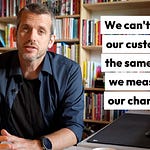Especially for cross-functional teams or separate business units wanting to collaborate more, I’ve found that some of their struggle can simply be related to the altitude at which they look a the world.
They are often too deep having developed specialist language and terminology, and being only focused on what is immediate to them.
If we raise the altitude teams can find that they have more things in common and more reasons to collaborate as they start looking at the same things and use the same language and terminology.
Let me give an example (in the video).
Example:
For this project we were working with eight different teams marketing the same product. Each of the teams were serving a unique medical indication (part of the body / specialist area where the product is applied).
These teams weren’t collaborating extensively, but there was a request that they would collaborate more. Our job was to find out where and how.
The first thing we did was map each team individually. We used a system thinking approach creating simple ‘ecosystem’ maps showing what had a positive or negative influence on something else helping us understand what led towards or away from our goal.
But our goal was not to show that they were all different, but how they were similar. So we needed to merge all these different maps into one.
In order to do that we did two significant things:
a. We removed specialist language and terminology. E.g. for each of these indications the medical professional would have a different title and speciality area of expertise. We simply stopped switched those terms with more descriptive ones depending on their role, e.g. medical professional, analyst, decision maker etc..
b. Given that each indication is a specialization within unique medical areas, complications and expertise we also needed to find an altitude where they had something in common. We chose the patient. Looking through the lens of the patient they all, independent of their indication, go through a similar process, feel the same mental and physical stress, have similar enough relationships with the medical system etc..
We created a shared map for all eight teams and asked them if this was a map of their market. They agreed.
The last thing we did was to give all the teams different colored dots, asking them to ‘power dot’ each area of the map which they would say was a priority for them.
What we ended up with was a simple map with clear visual indications of where which teams had an opportunity to collaborate and where they hadn’t.
Doing an exercise like this we are not trying to suggest that everyone needs to collaborate all the time. What we want to do is discover where teams can collaborate more and where they need to be different.
Using the altitude as a reference point for the level of specialization or generalization helps that.













Share this post